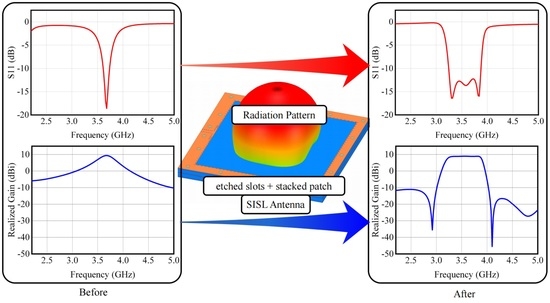A Filtering Antenna with Slots and Stacked Patch Based on SISL for 5G Communications
Abstract
:1. Introduction
2. Antenna Devise and Operating Principle
2.1. Configuration
2.2. Antenna Analysis
2.2.1. Three Resonance Frequencies
2.2.2. Three Radiation Nulls
2.2.3. Analysis of Critical Parameters
3. Antenna Measurement and Discussion
4. Conclusions
Author Contributions
Funding
Informed Consent Statement
Data Availability Statement
Conflicts of Interest
References
- Wu, P.-C.; Chen, L.; Luo, Y.-L. Miniaturised wideband filtering antenna by employing CRLH-TL and simplified feeding structure. Electron. Lett. 2015, 51, 548–550. [Google Scholar] [CrossRef]
- Sun, G.H.; Wong, S.W.; Zhu, L.; Chu, Q.X. A compact printed filtering antenna with good suppression of upper harmonic band. IEEE Antennas Wirel. Propag. Lett. 2016, 15, 1349–1352. [Google Scholar] [CrossRef]
- Ma, Z.K.; Vandenbosch, G.A.E. Wideband harmonic rejection filtenna for wireless power transfer. IEEE Trans. Antennas Propag. 2014, 62, 371–377. [Google Scholar] [CrossRef]
- Deng, J.; Hou, S.; Zhao, L.; Guo, L. A Reconfigurable Filtering Antenna with Integrated Bandpass Filters for UWB/WLAN Applications. IEEE Trans. Antennas Propag. 2018, 66, 401–404. [Google Scholar] [CrossRef]
- Li, L.; Liu, G. A differential microstrip antenna with filtering response. IEEE Antennas Wirel. Propag. Lett. 2016, 15, 1983–1986. [Google Scholar] [CrossRef]
- Mao, C.X.; Zhang, L.; Khalily, M.; Gao, Y.; Xiao, P. A multiplexing filtering antenna. IEEE Trans. Antennas Propag. 2021, 69, 5066–5071. [Google Scholar] [CrossRef]
- Wei, Z.H.; Zhou, Z.; Tang, Z.Y.; Yin, J.Y.; Ren, J.; Yin, Y.Z. Broadband filtering magnetoelectronic dipole antenna with quasi-elliptic gain response. IEEE Trans. Antennas Propag. 2020, 68, 3225–3230. [Google Scholar] [CrossRef]
- Tang, M.-C.; Li, D.J.; Wang, Y.; Hu, K.-Z.; Ziolkowski, R.W. Compact, low-profile, linearly and circularly polarized filtennas enabled with custom-designed feed-probe structures. IEEE Trans. Antennas Propag. 2020, 68, 5247–5256. [Google Scholar] [CrossRef]
- Liu, Y.-T.; Leung, K.W.; Yang, N. Compact absorptive filtering patch antenna. IEEE Trans. Antennas Propag. 2020, 68, 633–642. [Google Scholar] [CrossRef]
- Jin, J.Y.; Liao, S.W.; Xue, Q. Design of Filtering-Radiating Patch Antennas with Tunable Radiation Nulls for High Selectivity. IEEE Trans. Antennas Propag. 2018, 66, 2125–2130. [Google Scholar] [CrossRef]
- Liu, Q.W.; Zhu, L. A Compact Wideband Filtering Antenna on Slots-Loaded Square Patch Radiator under Triple Resonant Modes. IEEE Trans. Antennas Propag. 2022, 70, 9882–9887. [Google Scholar] [CrossRef]
- Chen, C.L. A Wideband Coplanar L-Probe-Fed Slot-Loaded Rectangular Filtering Microstrip Patch Antenna with High Selectivity. IEEE Antennas Wirel. Propag. Lett. 2022, 21, 1134–1138. [Google Scholar] [CrossRef]
- Zhang, Y.; Zhang, X.Y.; Liu, Q.H. A Dual-Layer Filtering SIW Slot Antenna Utilizing Double Slot Coupling Scheme. IEEE Antennas Wirel. Propag. Lett. 2021, 20, 1073–1077. [Google Scholar] [CrossRef]
- Li, J.F.; Chen, Z.N.; Wu, D.L.; Zhang, G.; Wu, Y.-J. Dual-Beam Filtering Patch Antennas for Wireless Communication Application. IEEE Trans. Antennas Propag. 2018, 66, 3730–3734. [Google Scholar] [CrossRef]
- Yang, W.-J.; Pan, Y.-M.; Zhang, X.-Y. A single-layer low-profile circularly polarized filtering patch antenna. IEEE Antennas Wirel. Propag. Lett. 2021, 20, 602–606. [Google Scholar] [CrossRef]
- Wong, S.W.; Huang, T.G.; Mao, C.X.; Chen, Z.N.; Chu, Q.X. Planar Filtering Ultra-Wideband (UWB) Antenna with Shorting Pins. IEEE Trans. Antennas Propag. 2013, 61, 948–953. [Google Scholar] [CrossRef]
- Yang, W.; Xun, M.; Che, W.; Feng, W.; Zhang, Y.; Xue, Q. Novel compact high-gain differential-fed dual-polarized filtering patch antenna. IEEE Trans. Antennas Propag. 2019, 67, 7261–7271. [Google Scholar] [CrossRef]
- Hu, K.-Z.; Tang, M.-C.; Li, D.; Wang, Y.; Li, M. Design of compact, single-layered substrate integrated waveguide filtenna with parasitic patch. IEEE Trans. Antennas Propag. 2020, 68, 1134–1139. [Google Scholar] [CrossRef]
- Yang, D.; Zhai, H.Q.; Guo, C.Z.; Li, H.K. A Compact Single-Layer Wideband Microstrip Antenna with Filtering Performance. IEEE Antennas Wirel. Propag. Lett. 2020, 19, 801–805. [Google Scholar] [CrossRef]
- Zhang, B.H.; Xue, Q. Filtering Antenna with High Selectivity Using Multiple Coupling Paths from Source/Load to Resonators. IEEE Trans. Antennas Propag. 2018, 66, 4320–4325. [Google Scholar] [CrossRef]
- Chen, B.-J.; Yang, X.-S.; Wang, B.-Z. A Compact High-Selectivity Wideband Filtering Antenna with Multipath Coupling Structure. IEEE Antennas Wirel. Propag. Lett. 2022, 21, 1654–1658. [Google Scholar] [CrossRef]
- Hu, H.-T.; Chan, C.H. Substrate-Integrated-Waveguide-Fed Wideband Filtering Antenna for Millimeter-Wave Applications. IEEE Trans. Antennas Propag. 2021, 69, 8125–8135. [Google Scholar] [CrossRef]
- Kulkarni, P.; Srinivasan, R. Compact polarization diversity patch antenna in L and WiMAX bands for IoT applications. AEU-Int. J. Electron. C 2021, 136, 153772. [Google Scholar] [CrossRef]
- Kulkarni, J.; Sim, C.Y.D.; Poddar, A.; Rohde, U.L.; Alharbi, A.G. A Compact Circularly Polarized Rotated L-Shaped Antenna with J-Shaped Defected Ground Strucutre for WLAN and V2X Applications. Prog. Electrom. Res. Lett. 2022, 102, 135–143. [Google Scholar] [CrossRef]
- Wang, T.; Yan, N.N.; Tian, M.; Luo, Y.; Ma, K.X. A Low-Cost High-Gain Filtering Patch Antenna with Enhanced Frequency Selectivity Based on SISL for 5G Application. IEEE Antennas Wirel. Propag. Lett. 2022, 21, 1772–1776. [Google Scholar] [CrossRef]
- Tian, M.; Yan, N.N.; Luo, Y.; Ma, K.X. A Low-Cost High-Gain Filtering Patch Antenna Using SISL Technology for 5G Application. IEEE Antennas Wirel. Propag. Lett. 2021, 20, 2270–2274. [Google Scholar] [CrossRef]
- Aminu, S.; Yan, N.N.; Luo, Y.; Ma, K.X. Bandwidth improvement of patch antenna and array with out-of-band rejection based on SISL platform for 5G applications. Microw. Opt. Technol. Lett. 2022, 64, 1455–1461. [Google Scholar] [CrossRef]
- Hao, J.; Yan, N.N.; Luo, Y.; Fu, H.; Ma, K.X. A Low-Cost Dual-Band Multimode High-Gain Stacked-Patch Antenna Based on SISL for 5G Applications. IEEE Antennas Wirel. Propag. Lett. 2022, 21, 4–8. [Google Scholar] [CrossRef]
- Yan, N.; Song, D.; Luo, Y.; Ma, K. A Low-Cost Miniaturized Filtering Dielectric Resonator Antenna Based on SISL for 5G Application. IEEE Trans. Antennas Propag. 2022, 70, 11344–11352. [Google Scholar] [CrossRef]
- Luo, Y.; Yin, T.; Yan, N.; An, W.; Ma, K. A Low-Cost Differentially Fed Dual-Mode Filtering MIMO Antenna with Enhanced Isolation Based on SISL Platform. IEEE Antennas Wirel. Propag. Lett. 2022, 21, 198–202. [Google Scholar] [CrossRef]
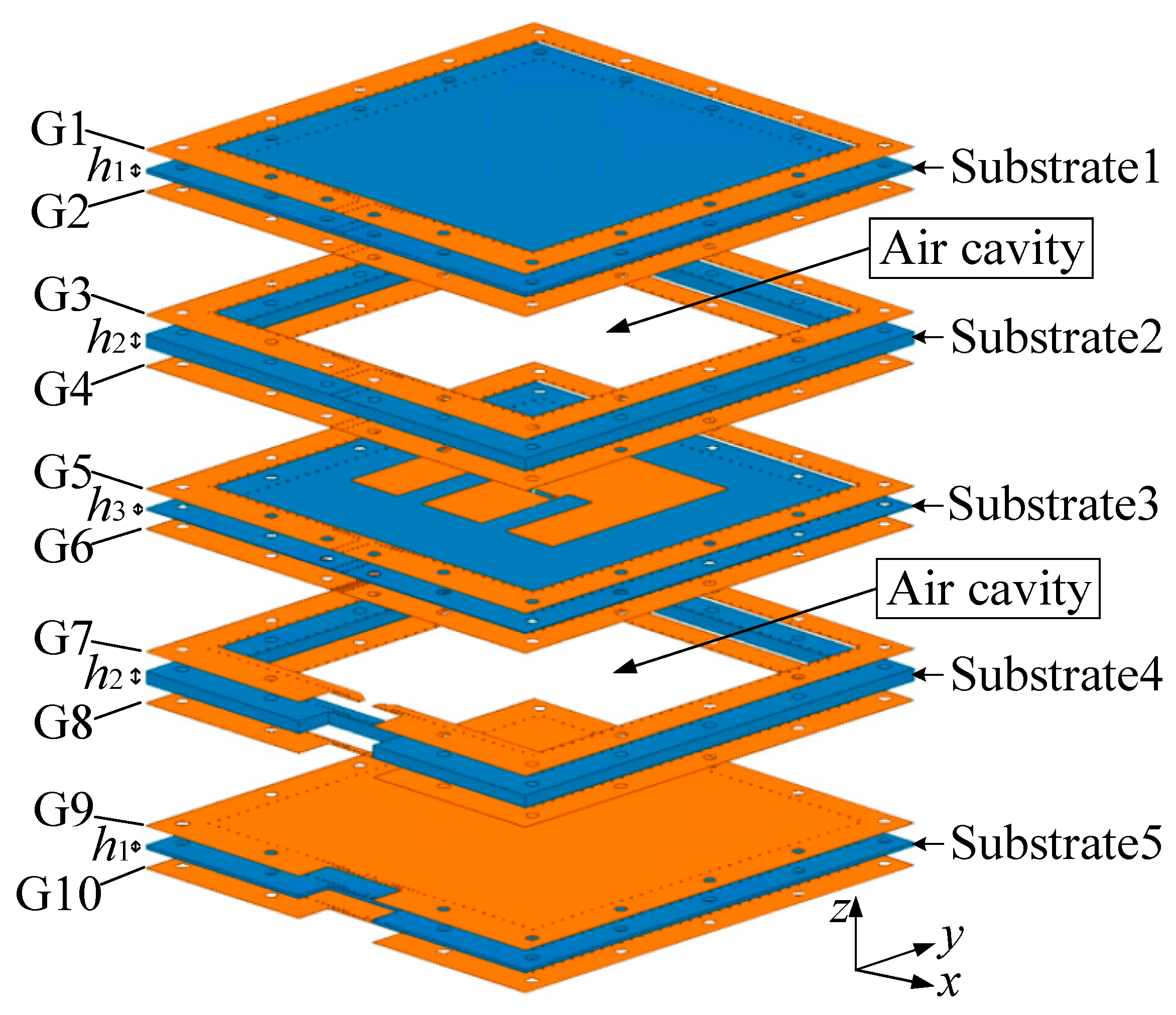
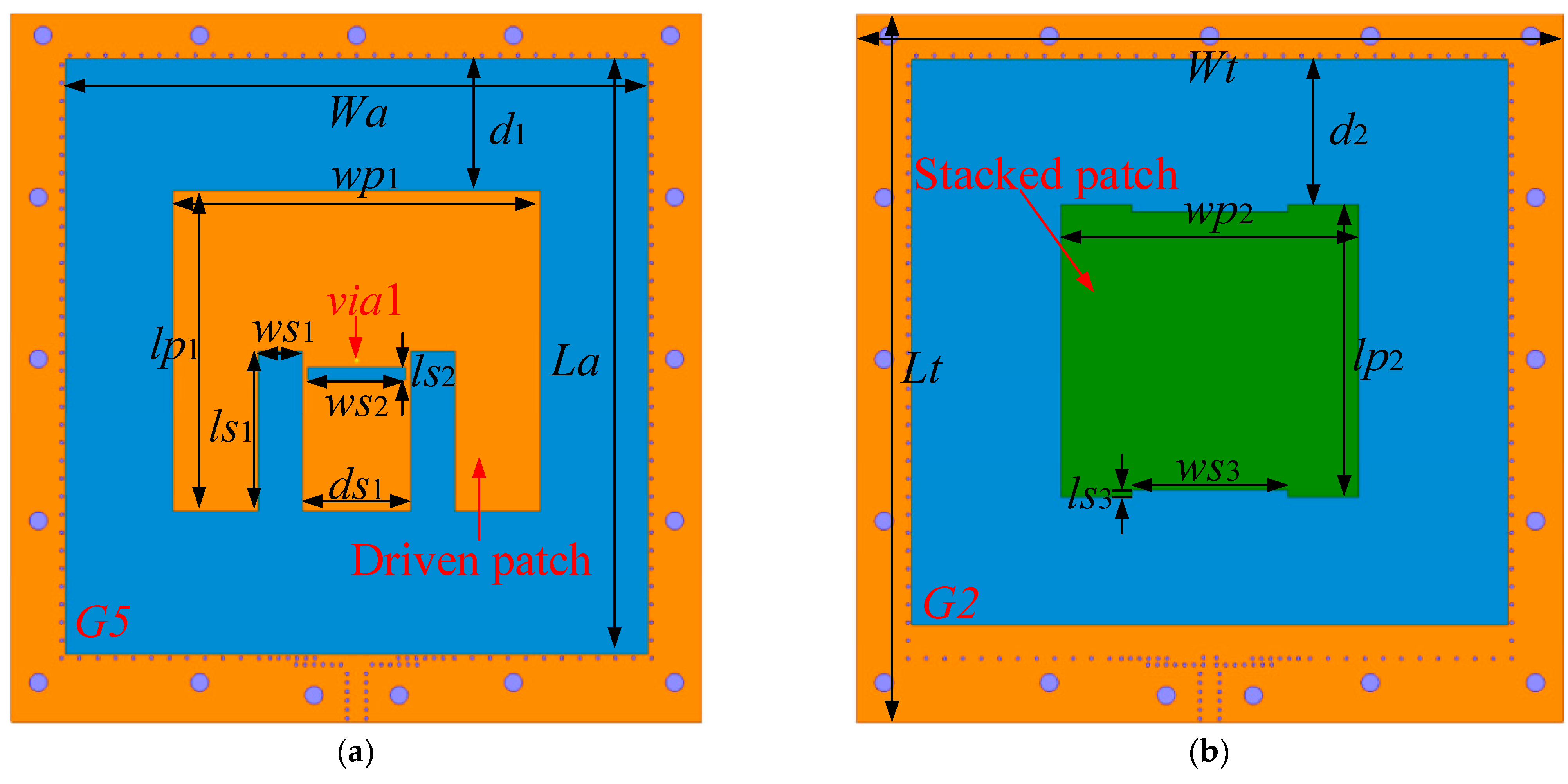
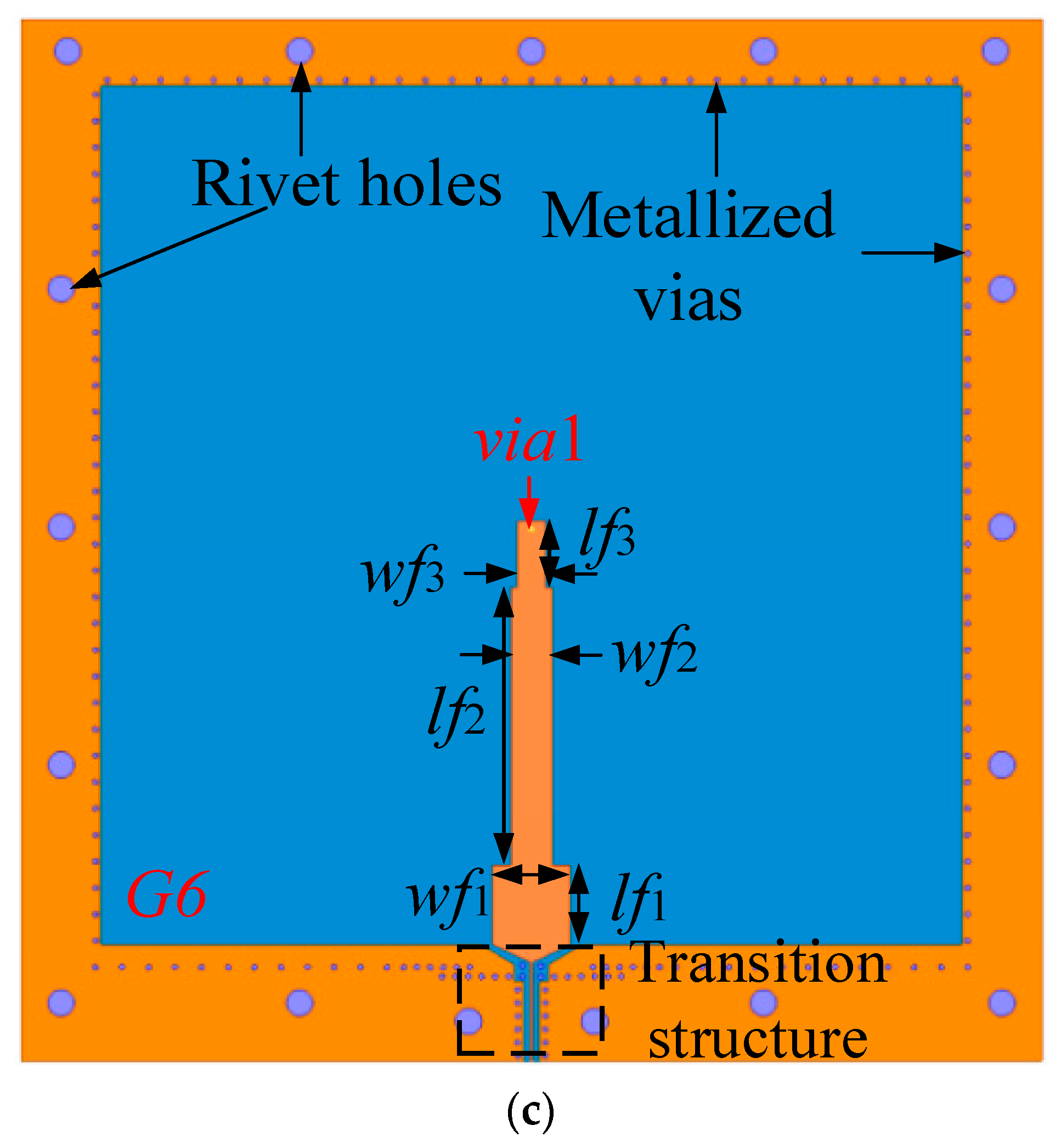

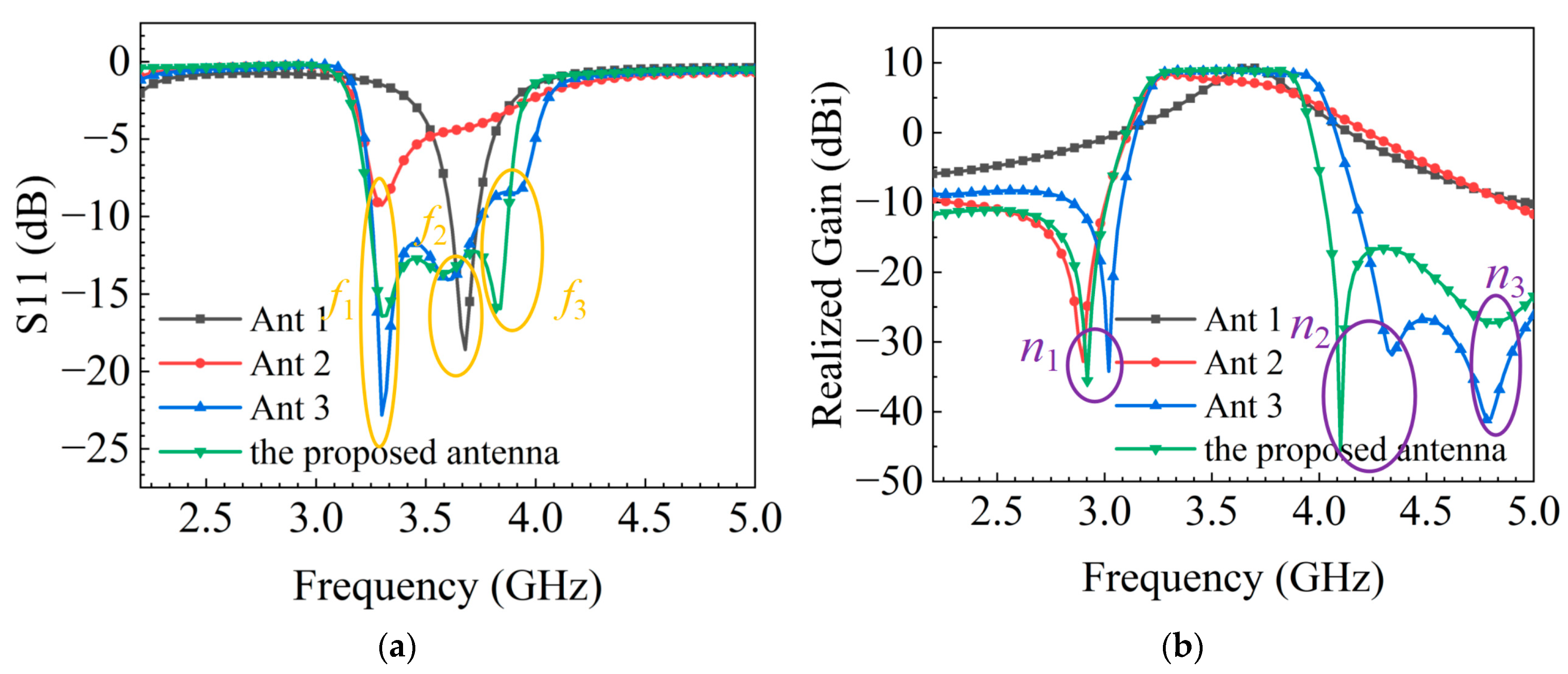

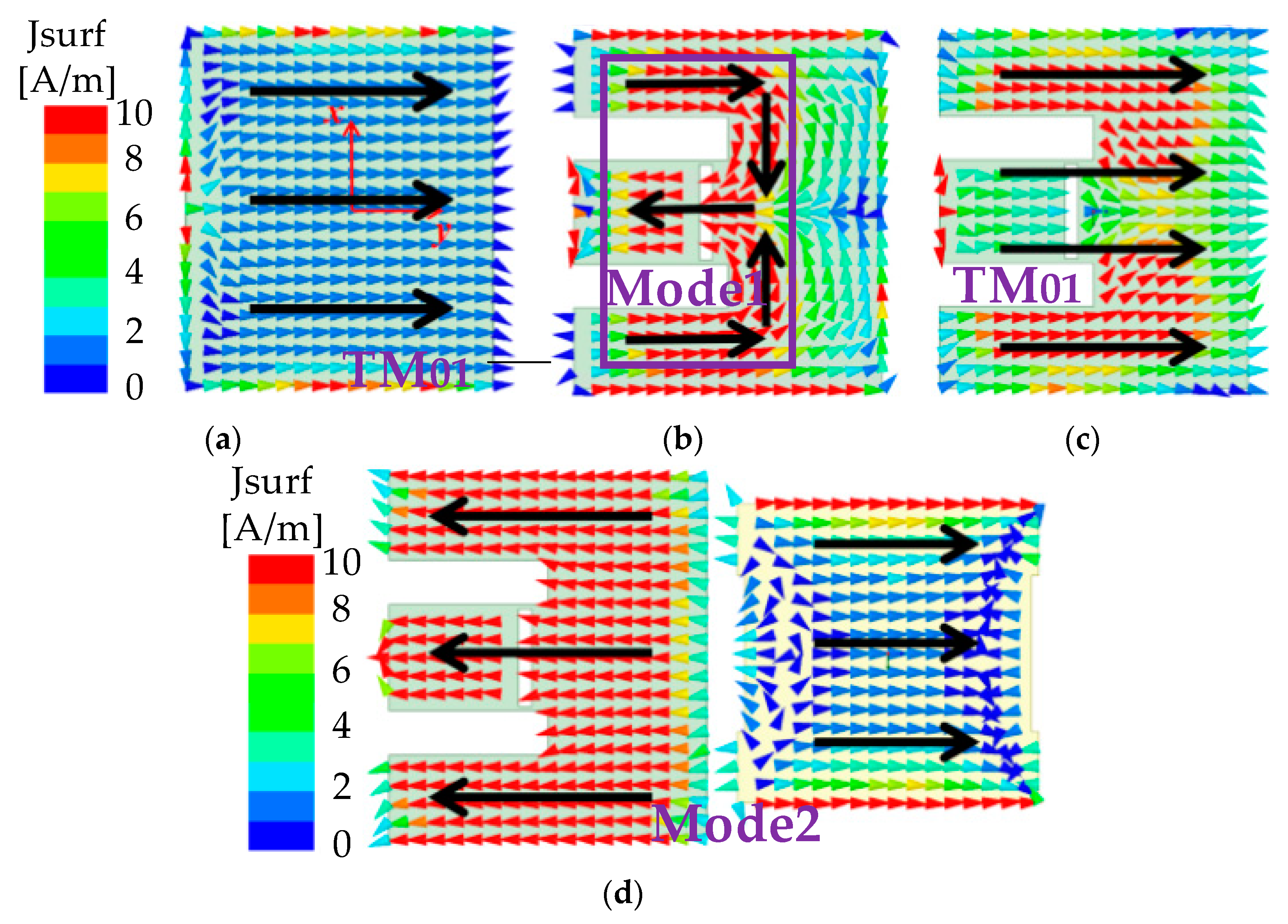


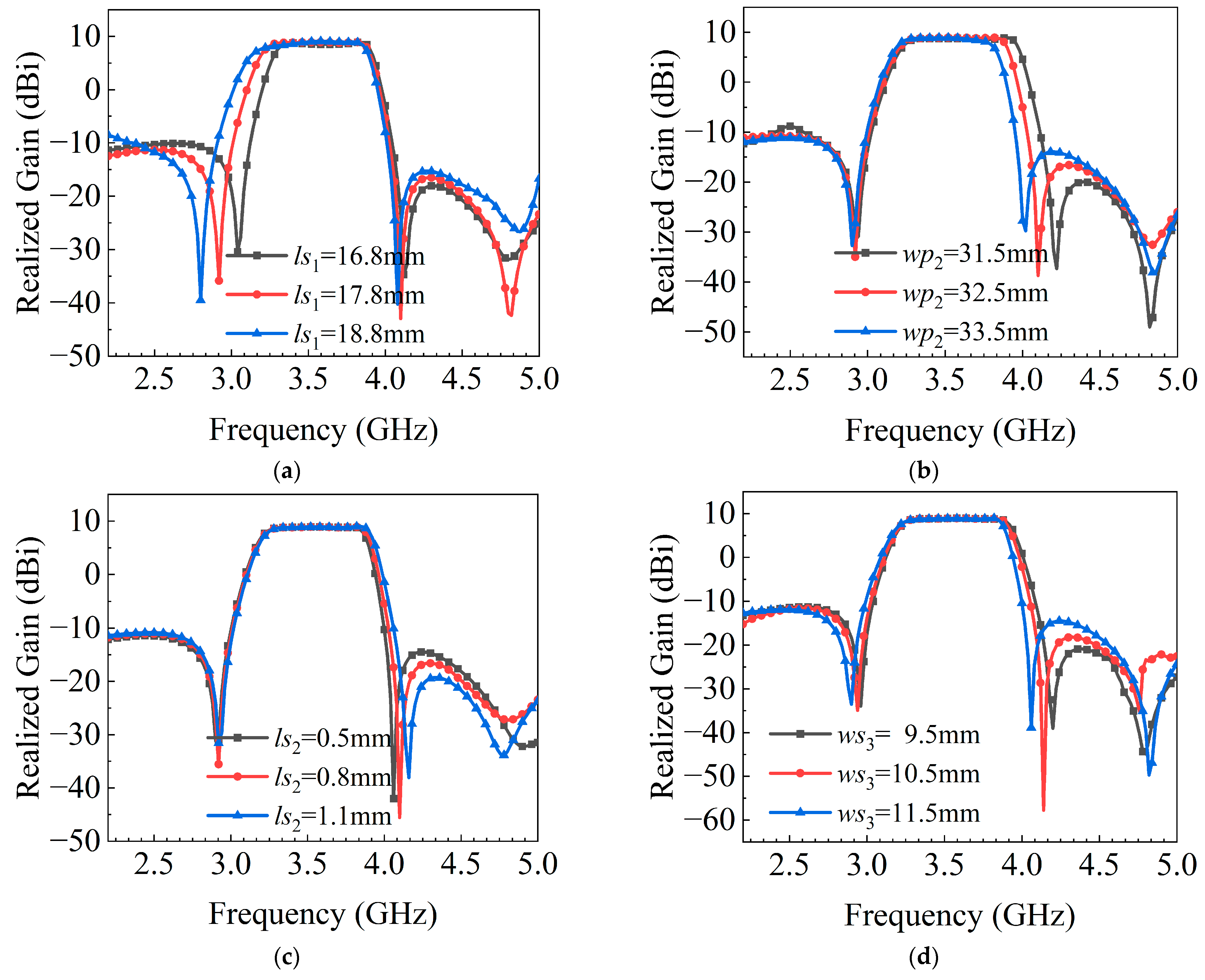
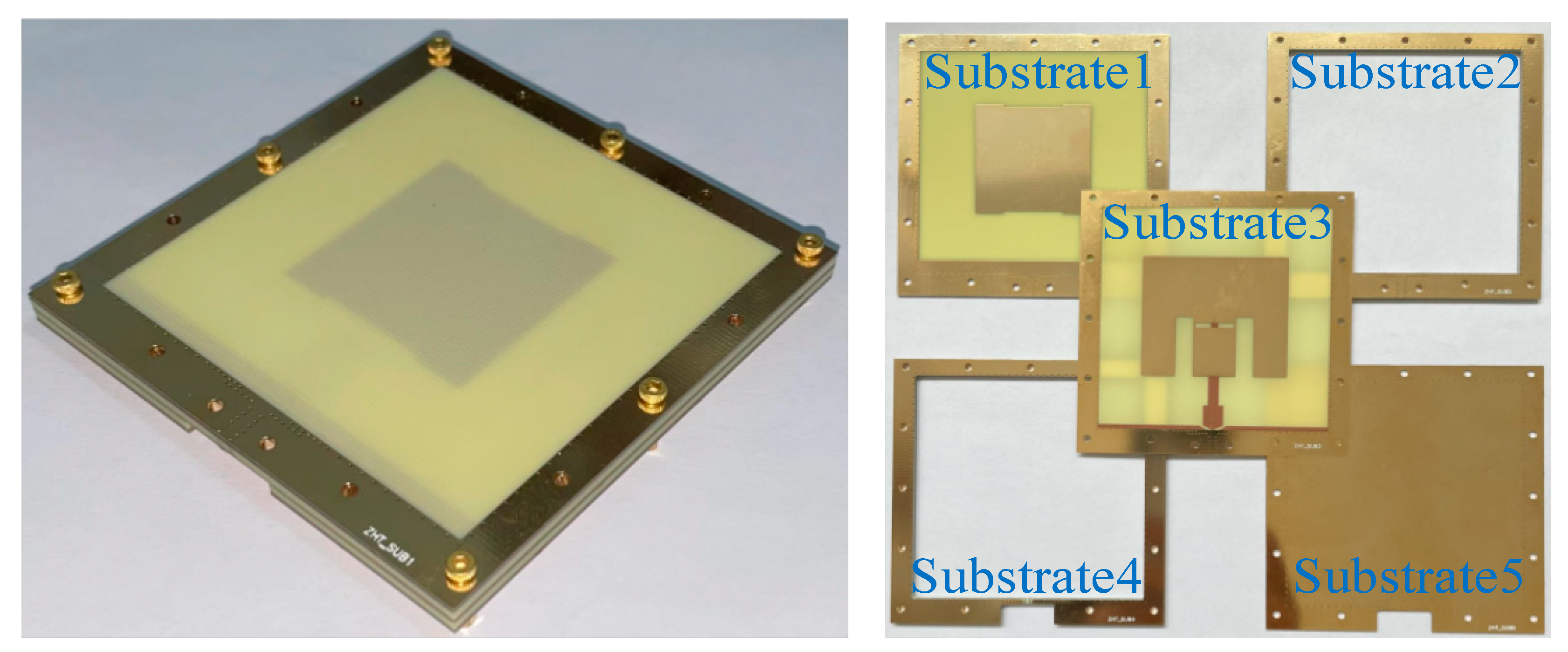
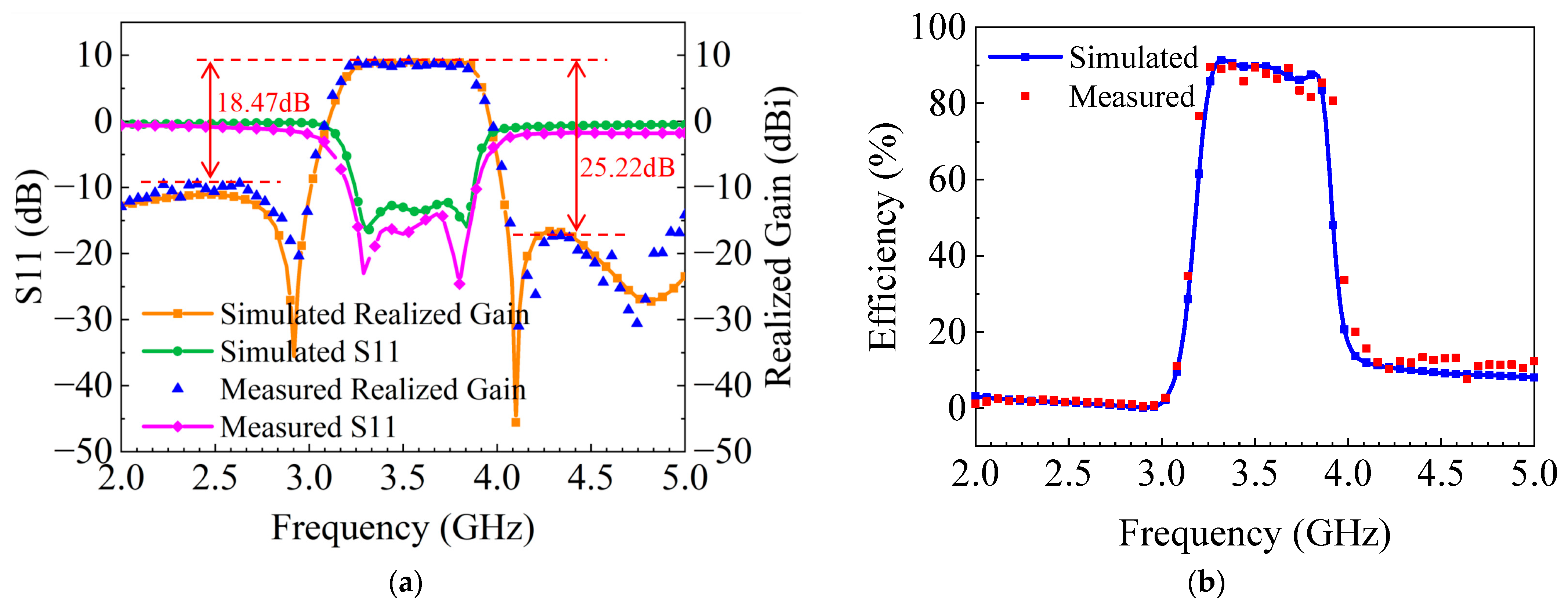
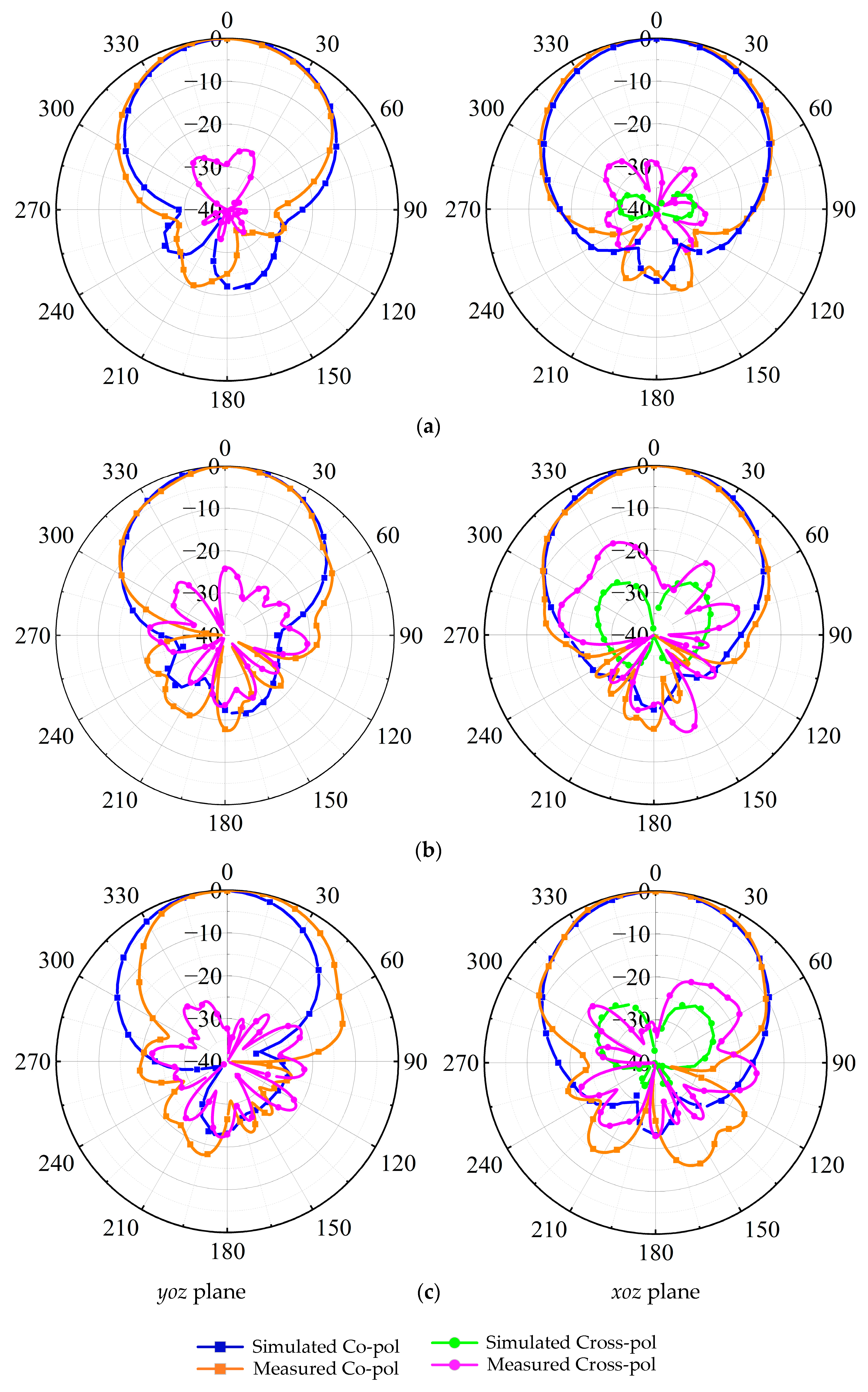
| Parameter | Value | Parameter | Value | Parameter | Value |
|---|---|---|---|---|---|
| Wt | 77 | lp1 | 35.6 | ls3 | 1.5 |
| Lt | 78.8 | wp1 | 41 | ws3 | 11 |
| Wa | 65 | lp2 | 32.5 | lf1 | 6 |
| La | 66.3 | wp2 | 32.5 | wf1 | 5.8 |
| La1 | 63 | ls1 | 17.8 | lf2 | 21 |
| d1 | 14.7 | ws1 | 5 | wf2 | 3.1 |
| d2 | 20.125 | ls2 | 0.8 | lf3 | 5 |
| ds1 | 11 | ws2 | 17 | wf3 | 2.1 |
| h1 | 0.6 | h2 | 2 | h3 | 0.127 |
| Ref. | Bandwidth (GHz) | Peak Gain (dBi) | Rejection Level (dB) | Size (λ03) | Material |
|---|---|---|---|---|---|
| [11] | 3.34–3.66 (9.14%) | 7.6 | 12.7 | 0.457 × 0.457 × 0.043 | F4B |
| [16] | 2.3–2.9 (23%) | 8.9 | 20 | 0.8 × 0.8 × 0.06 | None |
| [17] | 2.705–2.847 (5.1%) | 6.3 | None | 0.76 × 0.44 × 0.015 | Taconic TLY-5 |
| [20] | 2.15–2.5 (15.2%) | 5.2 | 13 | 0.66 × 0.62 × 0.062 | RO4003C |
| [21] | 4.45–5.52 (21.5%) | 4.8 | 15.9 | 0.4 × 0.4 × 0.09 | F4BM |
| [23] | 1.575 (3.5%) & 3.4–3.6 (5.71%) | 3.15 & 4.3 | None | 0.13 × 0.13 × 0.067 | ARLON 1000 |
| [24] | 4.8–5.99 (22.05%) | 2.5 | None | 0.55 × 0.55 × 0.014 | FR4 |
| [26] | 4.28–5.34 (22.04%) | 10.4 | 14.5 | 0.78 × 0.8 × 0.08 | FR4 |
| This | 3.2–3.89 (19.5%) | 9.21 | 18.47 | 0.93 × 0.91 × 0.06 | FR4 |
Disclaimer/Publisher’s Note: The statements, opinions and data contained in all publications are solely those of the individual author(s) and contributor(s) and not of MDPI and/or the editor(s). MDPI and/or the editor(s) disclaim responsibility for any injury to people or property resulting from any ideas, methods, instructions or products referred to in the content. |
© 2023 by the authors. Licensee MDPI, Basel, Switzerland. This article is an open access article distributed under the terms and conditions of the Creative Commons Attribution (CC BY) license (https://creativecommons.org/licenses/by/4.0/).
Share and Cite
Yan, N.; Zhou, H.; Ma, K. A Filtering Antenna with Slots and Stacked Patch Based on SISL for 5G Communications. Electronics 2023, 12, 1331. https://doi.org/10.3390/electronics12061331
Yan N, Zhou H, Ma K. A Filtering Antenna with Slots and Stacked Patch Based on SISL for 5G Communications. Electronics. 2023; 12(6):1331. https://doi.org/10.3390/electronics12061331
Chicago/Turabian StyleYan, Ningning, Hetian Zhou, and Kaixue Ma. 2023. "A Filtering Antenna with Slots and Stacked Patch Based on SISL for 5G Communications" Electronics 12, no. 6: 1331. https://doi.org/10.3390/electronics12061331
APA StyleYan, N., Zhou, H., & Ma, K. (2023). A Filtering Antenna with Slots and Stacked Patch Based on SISL for 5G Communications. Electronics, 12(6), 1331. https://doi.org/10.3390/electronics12061331





